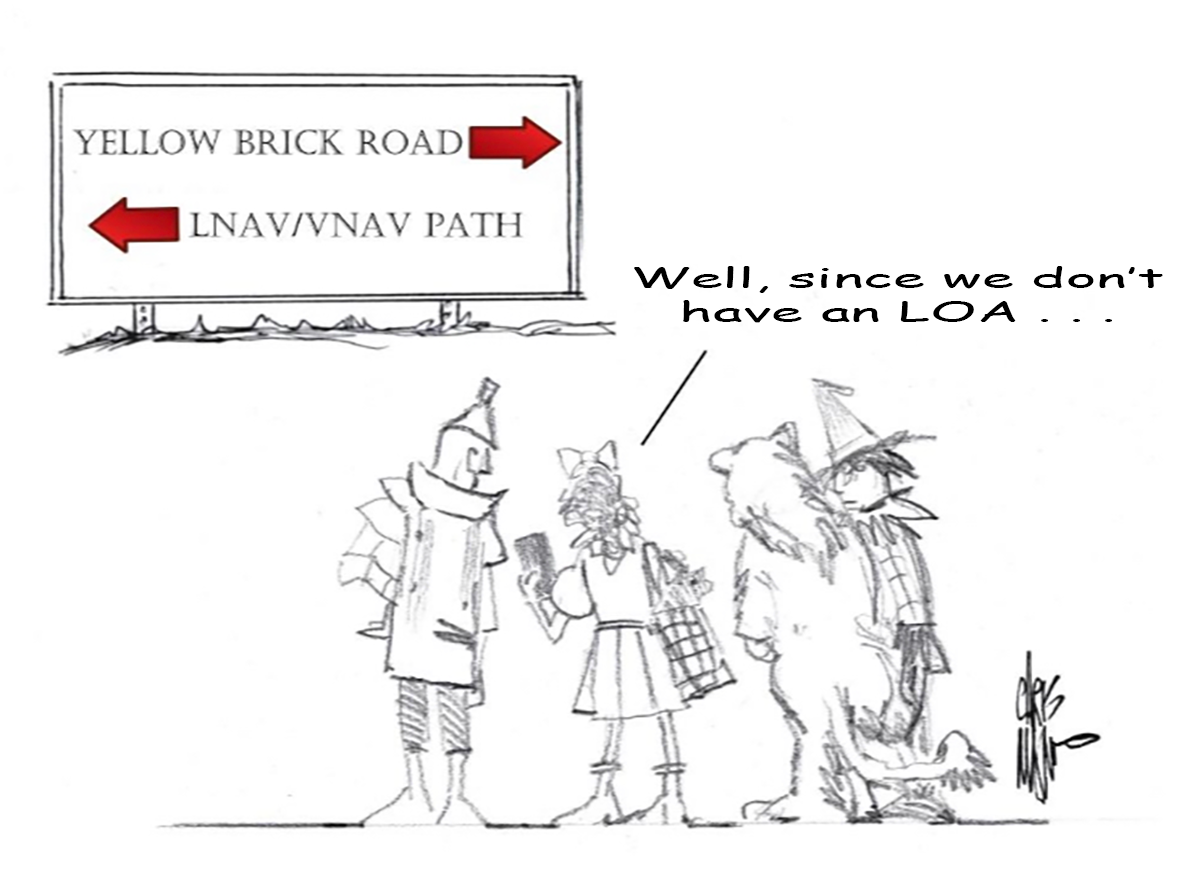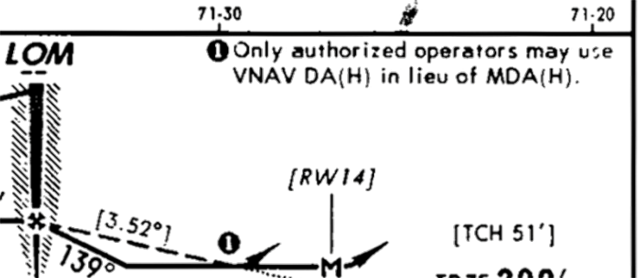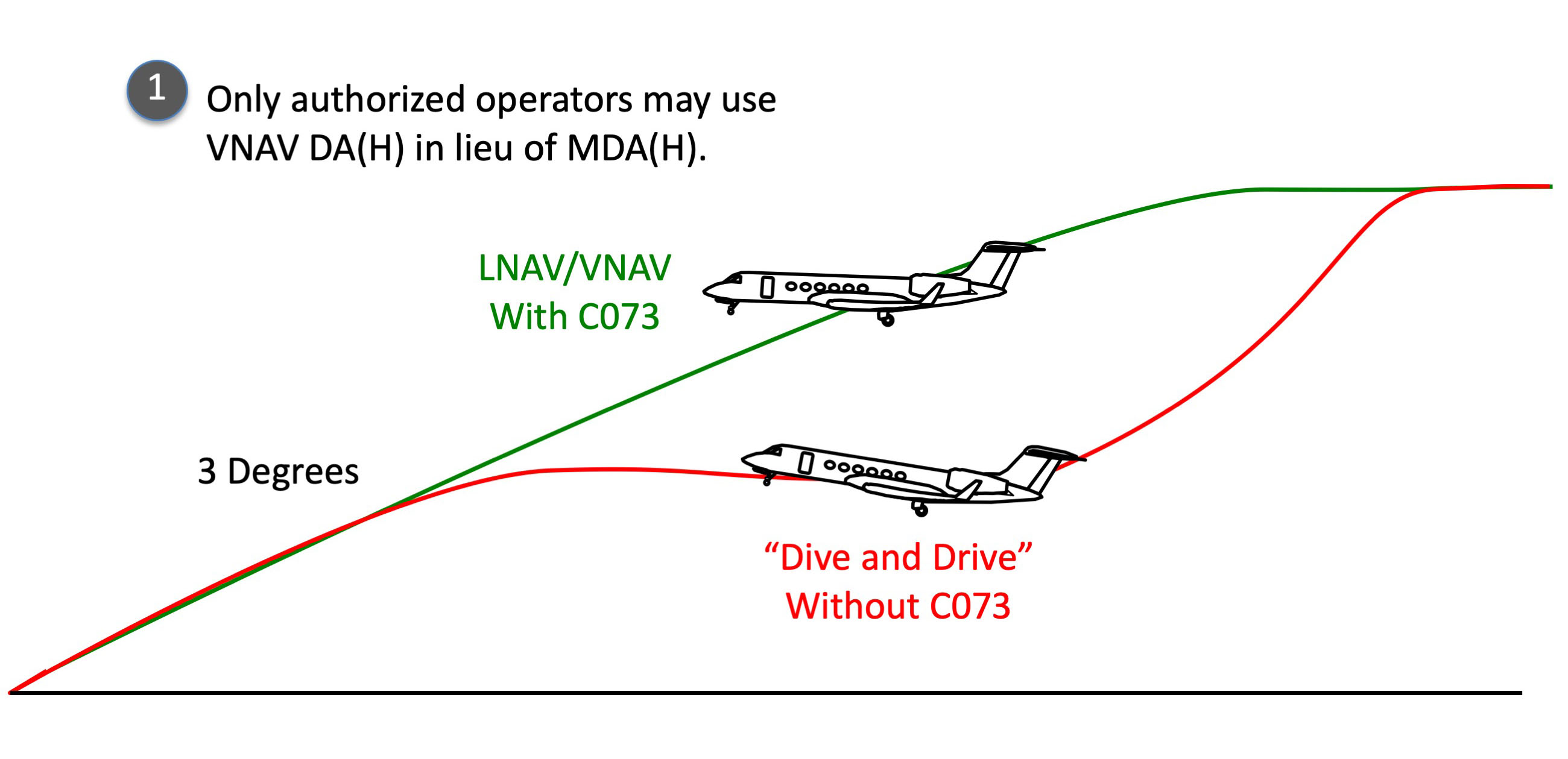Let's put the bottom line on top here. Can you use your VNAV down to a DA in lieu of an MDA in instrument conditions? If you are flying an RNAV (GPS) approach with published LNAV/VNAV minimums with a local altimeter setting: yes you can.
— James Albright

Updated:
2016-03-26
What about one of those other kinds of approaches with the "Only Authorized Operators" ball note?
- If you are a commercial operator with OpSpec C073 flying a commercial leg and the approach meets several requirements: yes.
- If you are Part 91 with LOA C073 and the approach meets several requirements: yes.
- If you don't have OpSpec, MSpec, or LOA C073: no, sort of. You can still fly a CDFA. See Continuous Descent Final Approach.
- So if you want to be an "authorized operator" you need C073.
- All this is covered in FAA Order 8900, Volume 3, Chapter 18, §5, Part C for OpSpec/MSpec users, as well as for Part 91 LOA users. (A bit of history: up until December 2013 non-commercial operators were not included, at that point FAA National Policy N 8900.248 added them, but then it expired. Now it has been incorporated into the 8900 series.)

1
Regulatory information
Operator Eligibility: LNAV/VNAV Approaches
This appendix addresses those systems using barometric altitude and navigation system information in the definition of vertical flightpaths and vertical tracking to a path. Baro-VNAV provides vertical path information defined by vertical angles or altitudes at fixes in the RNP APCH procedure. This specification provides system and operational criteria for the approval of a vertical navigation (VNAV) system using barometric altimetry as a basis for its vertical navigation capability.
This appendix applies to all operators conducting baro-VNAV operations under Title 14 of the Code of Federal Regulations (14 CFR) parts 91, 91 subpart K (91K), 121, 125, 129, and 135 within the U.S. National Airspace System (NAS). This appendix also provides guidance for approval to use baro-VNAV equipment to perform 14 CFR part 97 Area Navigation (RNAV) (Global Positioning System (GPS)) or GPS instrument approach procedures (IAP) published with a lateral navigation (LNAV)/VNAV line of minima with a decision altitude (DA).
Source: AC 90-105A, Appendix B, ¶B.
Aircraft Eligibility: LNAV/VNAV Approaches
Eligible aircraft are those which meet the performance and functional requirements outlined in Appendix A, Qualification Criteria for Required Navigation Performance Approach (RNP APCH) Operations, and Appendix C, Qualification Criteria for Required Navigation Performance (RNP) 1 (Terminal) Operations, as appropriate for the RNP operation.
Source: AC 90-105A, Appendix B, ¶B.3.1
- Aircraft with approval to conduct RNAV (GPS) or GPS approaches meet the performance and functional requirements in this AC for RNP APCH instrument approaches without RF legs.
- Statement of Compliance (SOC). Aircraft with a SOC with the criteria in this AC in their Airplane Flight Manual (AFM), Airplane Flight Manual Supplement (AFMS), pilot’s operating handbook (POH), or the operating manual for their avionics meet the performance and functional requirements of this AC.
- Statement from the Manufacturer. Aircraft with a statement from the manufacturer documenting compliance with the criteria in AC 20-138( ), Airworthiness Approval of Positioning and Navigation Systems, meet the performance and functional requirements of this AC. Manufacturer documentation can include Service Bulletins (SB) or Service Letters (SL). These statements should include the airworthiness basis for compliance. AFM/Rotorcraft Flight Manual (RFM) entries are not required provided the Federal Aviation Administration (FAA) accepts the manufacturer’s documentation.
Source: AC 90-105A, Appendix A, ¶A.2
Eligible aircraft are those with an Airplane Flight Manual (AFM)/Rotorcraft Flight Manual (RFM) or Airplane Flight Manual Supplement (AFMS)/Rotorcraft Flight Manual Supplement (RFMS) which explicitly states that the VNAV system is approved for approach operations in accordance with Advisory Circular (AC) 20-138( ), Airworthiness Approval of Positioning and Navigation Systems. Aircraft accomplishing RNP APCH operations (RNAV (GPS) or RNAV (Global Navigation Satellite System (GNSS)) are required to monitor lateral and, if approved for operational credit, vertical guidance deviations. Aircraft qualified using AC 20-138( ) must allow the pilot to readily distinguish if the cross-track (XTK) deviation exceeds the RNP value (or a smaller value) or if the vertical deviation exceeds 75 feet (or a smaller value). Aircraft with an authorization for Required Navigation Performance Authorization Required (RNP AR) operations are considered eligible for baro-VNAV operations conducted in accordance with this AC.
Source: AC 90-105A, Appendix B, ¶B.3.2
If you have the necessary statements in your AFM, you are authorized to fly a vertical flight path using Baro-VNAV to a decision altitude on a 14 CFR 97 RNAV(GPS) approach.
Operator Eligibility: Other Approaches
OpSpec/MSpec/LOA C073 is applicable to all certificate holders/operators/program managers conducting airplane operations under 14 CFR parts 91, 91 subpart K (part 91K), 121, 125 (including part 125 Letter of Deviation Authority (LODA) holders), and 135.
The VNAV operating concept is to fly approach procedures using VNAV guidance with a defined Vertical Path (VPATH) that provides a continuous descent final approach (CDFA). All 14 CFR part 97 non-precision Approach (NPA) straight-in IAPs may be flown using an MDA as a DA/DH.
NOTE: The use of MDA as a DA/DH does not ensure obstacle clearance from the MDA to the landing runway. Operators must see and avoid obstacles between the MDA and the runway when §91.175 requirements are met and the approach is continued below the MDA for landing.
Source: FAA Order 8900, Volume 3, Chapter 18, §5, Part C, OpSpec/MSpec/LOA C073, ¶A, B, and C
So the concept is that we can apply the VNAV to a DA in lieu of an MDA for "all 14 CFR part 97 non-precision approach straight-in IAPs" if we have C073. But there is a catch:
See and avoid? If you fast forward a few paragraphs it gets even murkier:
Authorized Approaches. The certificate holder/operator/program manager may fly all part 97 non-precision straight-in IAPs listed as authorized in their OpSpec/MSpec/LOA C052, Table 1, columns 1 and 2 (C052 not applicable to part 91 operators), using an MDA as a DA/DH if the approach meets one of the following requirements and its subcomponents:
1) Serves a runway that has a published RNAV IAP (“RNAV (GPS),” “RNAV (RNP),” or “GPS” in the title) with a published LNAV/VNAV or RNP DA, and:
a) Has the exact published final approach course as the RNAV IAP.
b) Has a published VDA coincident with or higher than the the barometric vertical guidance GS on the published RNAV IAP.
NOTE: A published VDA is not required when using the LNAV minima line on an RNAV approach that has a published LPV or LNAV/VNAV DA. Use the published GS. The VNAV path must be at or above all stepdown fixes.
c) Is selected from an approved and current database and the FMS displays a final approach Flight Path Angle (FPA) in tenths or hundredths. The displayed FPA may have a maximum difference of minus .04 from the IAP VDA or GS. The displayed FPA may always be rounded up to the next tenth. The range for a given FPA will be 2.9 to 3.0, 3.1 to 3.2, 3.2 to 3.3, 4.0 to 4.1, etc. See examples below.
1. For FMS FPAs displayed in tenths, 3.1 may be displayed for a published IAP with a VDA or GS of 3.10 to 3.14. An FPA of 3.2 may be displayed for a published IAP with a VDA of 3.10 to 3.20.
2. For FMS FPAs displayed in hundredths, 3.10 may be displayed if the FMS FPA does not match the published IAP with a VDA or GS of 3.10 to 3.14. An FPA of 3.20 may be displayed for a published IAP with a VDA of 3.10 to 3.20.
NOTE: Aircraft without an FMS FPA display meeting previous AC 20-129 criteria may have been approved for LNAV/VNAV approaches using baro-VNAV. Certificate holders/operators/program managers currently approved C073, using AC 20-129 criteria, may continue C073 operations.
Source: FAA Order 8900, Volume 3, Chapter 18, §5, Part C, OpSpec/MSpec/LOA C073, ¶F.
If you are flying an RNAV(GPS) with a published LNAV/VNAV or RNP DA selected from your database, you are good to go.
2) Serves a runway that has a published ILS, GLS, or RNAV IAP with LPV minima and:
a) Has the exact published final approach course as the ILS, GLS, or RNAV IAP.
b) Has a published VDA or GS coincident with or higher than the GS on the published ILS, GLS, or RNAV IAP.
1. A published VDA is not required on a LOC-only approach when the ILS GS is out of service. Use the published GS. VNAV path must be at or above all stepdown fixes.
2. A published VDA is not required when using the LNAV minima line on an RNAV approach that has a published LPV or LNAV/VNAV DA. Use the published GS. VNAV path must be at or above all stepdown fixes.
c) Is selected from an approved and current database and the FMS displays a FPA in tenths or hundredths. The displayed FPA may have a maximum difference of minus .04 from the IAP VDA or GS. The displayed FPA may always be rounded up to the next tenth. The range for a given FPA will be 2.9 to 3.0, 3.1 to 3.2, 3.2 to 3.3, 4.0 to 4.1, etc. See examples below.
1. For FMS FPAs displayed in tenths, 3.1 may be displayed for a published IAP with a VDA or GS of 3.10 to 3.14. An FPA of 3.2 may be displayed for a published IAP with a VDA or GS of 3.10 to 3.20.
2. For FMS FPAs displayed in hundredths, 3.10 may be displayed if the FMS FPA does not match the published IAP with a VDA or GS of 3.10 to 3.14. An FPA of 3.20 may be displayed for a published IAP with a VDA of 3.10 to 3.20.
NOTE: Aircraft without an FMS FPA display meeting previous AC 20-129 criteria may have been approved for LNAV/VNAV approaches using baro-VNAV. Certificate holders/operators/program managers currently approved C073, using AC 20-129 criteria, may continue C073 operations.
Source: Source: FAA Order 8900, Volume 3, Chapter 18, §5, Part C, OpSpec/MSpec/LOA C073, ¶F.
With just a few caveats, if you are flying an approach to a runway with a published ILS, GLS, LPV and you have a way of flying a VNAV glide path that mimics the flight path angle, you are good to go. The ILS can be out of service, for example, but if your FMS can draw a glide path where that glide slope would have been, you are good to go.
3) Serves a runway to an airport operating under 14 CFR part 139 with a VGSI.
a) The VDA or GS on the published final approach course must be coincident with or higher than the published VGSI descent angle.
b) The published final approach course is within plus or minus 4 degrees of the runway centerline (RCL) course.
Source: Source: FAA Order 8900, Volume 3, Chapter 18, §5, Part C, OpSpec/MSpec/LOA C073, ¶F.
A Part 139 airport is one that serves commercial air carriers, with some exceptions.
2
Barometric VNAV procedures
Actions at DA.
The pilot/crew is expected to fly the aircraft along the published vertical path and execute a missed approach procedure upon reaching DA, unless the visual references specified in 14 CFR § 91.175 for continuing the approach are present.
Source: AC 90-105A, Appendix B, ¶B.4.1
More about: Minimums.
Temperature Limitation.
Because of the pronounced effect of nonstandard temperature on baro-VNAV operations, VNAV approaches will contain a temperature limitation below which use of the VNAV DA, based on baro-VNAV, is not authorized. The temperature limitation will be shown as a note on the procedure. If the airborne system contains a temperature compensation capability, manufacturer instructions should be followed for use of the baro-VNAV function.
Source: AC 90-105A, Appendix B, ¶B.4.2
More about this: Altimeter Temperature Compensation.
Remote Altimeter Setting Restriction.
Use of baro-VNAV to a DA is not authorized with a remote altimeter setting. A current altimeter setting for the landing airport is required. Where remote altimeter minima are shown, the VNAV function may be used but only to the published LNAV MDA.
Source: AC 90-105A, Appendix B, ¶B.4.4
Altimeter Crosscheck.
Where two pilots are required, the flightcrew must complete an altimetry cross-check ensuring both pilots’ altimeters agree within ±100 feet prior to the FAF after receiving the current local altimeter setting at the airport of intended landing. If the altimetry cross-check fails then the procedure should not be conducted or, if in progress, it must not be continued. The flightcrew procedures should also address actions to take if a comparator warning for the pilots’ altimeters occurs while conducting a RNP APCH procedure. NOTE: This operational crosscheck is not necessary if the aircraft automatically compares the altitudes to within 100 feet.
Source: AC 90-105A, Appendix B, ¶B.4.5.2
3
No published vertical descent angle
If the approach plate does not have a published vertical descent angle, you need to obey the MDA if you don't have visual guidance.
- The Federal Aviation Administration (FAA) believes advisory vertical guidance can aid the pilot when flying the final approach segment of IAPs without a glideslope or an approved glide path. As a result, there were multiple public requests for the FAA to publish vertical descent angles on these IAPs. Many manufacturers then chose to use the published vertical descent angle when providing advisory vertical guidance for these IAPs.
- The types of IAPs the FAA publishes with a vertical descent angle to help provide advisory vertical guidance include: 1) conventional IAPs (i.e., very-high frequency omni-directional receiver (VOR), localizer-type directional aid (LDA), simplified directional facility (SDF), etc.); and 2) required navigation performance IAPs titled “RNAV (GPS) RWY XX” with stand-alone lateral navigation (LNAV) and/or localizer performance without vertical guidance (LP) lines of minima.
- The published vertical descent angle and navigation equipment-generated advisory vertical guidance offers no guarantee of meeting altitude constraints. Advisory vertical guidance does not guarantee obstacle protection or compliance with procedural altitudes. Advisory vertical guidance solely offers an aid to help pilots establish a continuous, stabilized descent during the final approach of the IAP and avoiding the traditional “dive and drive” method. Pilots must use the primary barometric altimeter to comply with all air traffic clearances and altitude constraints.
- When the FAA charts these IAPs, they do not show a vertical descent angle in the profile view.
- The charts currently include the following statement: “Descent Angle NA”. Like flying any other IAP, the pilot must see and avoid any obstacles in the visual segment during transition to landing.
- The affected IAPs may create a hazard if the pilot continued to reference the advisory vertical guidance while transitioning to the visual segment of the approach. To avoid creating a possible hazard, FAA procedure designers began excluding a vertical descent angle from these IAPs and coding a “0” (zero) in the appropriate ARINC 424 database format specifications to communicate the absence of the vertical descent angle.
- Some flight management systems (FMS), multi-mode receivers (MMR), and GPS navigation equipment may experience unintended consequences if they attempt to use a “0” (zero) from the packed, onboard navigation database for the vertical descent angle. Examples of navigation equipment unintended consequences from a “0” (zero) in the packed navigation data include:
- Using the “0” (zero) and generating problematic, inaccurate vertical path guidance.
- Loading the IAP to the navigation system’s flight plan, but then failing to generate any horizontal or vertical guidance when the approach becomes active.
- Creating a “divide by zero” mathematical error preventing the navigation equipment from loading the IAP or, functioning properly when the system loads the IAP.
- Generating nuisance cockpit alerts for “low glide path angle”.
- Assuming a “0” (zero) is invalid because the angle is too low then automatically defaulting to a three degree (3o) angle.
- “Rejecting” the affected IAPs during the database packing process and removing them from the onboard navigation database; making the IAPs unavailable from the onboard navigation database when pilots attempt to select them.
- The FAA recommends operators and pilots carefully review departure, destination and alternate airport IAPs during pre-flight operations. During this review, operators and pilots should look for IAPs published with no vertical descent angle and charted with the statement: “Descent Angle NA” or “Descent Angle NA – Obstacles” in the profile view of the procedure. For these IAPs, the FAA recommends finding and planning to use another IAP (if available) not affected by this airworthiness concern.
Source: SAIB HQ-14-25
The Honeywell answer is this:
- Flight crews are responsible to ensure obstacle clearance in the visual segment for procedures identified by the FAA as ‘Descent Angle NA’ or ‘Descent Angle NA – Obstacles’.
- As with all step down fixes, flight crews must verify altitude clearances.
- Honeywell is working to either include the descent angle to ensure the FMS will clear those step down fix altitudes or to remove the affected procedures from the navigation database.
- Until these procedures are either removed or mitigation is approved, operators are encouraged to follow the FAA recommendation from the SAIB.
Source: Honeywell SIL Publication Number D201504000004
References
(Source material)
14 CFR 91, Title 14: Aeronautics and Space, General Operating and Flight Rules, Federal Aviation Administration, Department of Transportation
Advisory Circular 90-105A, Approval Guidance for RNP Operations and Barometric Vertical Navigation in the U.S. National Airspace System and in Oceanic and Remote Continental Airspace, 3/7/2016, U.S. Department of Transportation
FAA National Policy N 8900.248, OpSpec/MSpec/LOA C073, Vertical Navigation (VNAV) Instrument Approach Procedures (IAP) Using Minimum Descent Altitude (MDA) as a Decision Altitude (DA)/Decision Height (DH), 12/11/13
FAA Orders 8400 and 8900
Honeywell Service Information Letter, Publication Number D201504000004, 11 Aug 2015
Special Airworthiness Information Bulletin HQ-14-25, FMS and GPS Equipment Advisory Vertical Guidance with no Vertical Descent Angle, August 26, 2014



